A time to reflect, observe and become aware as I walk.
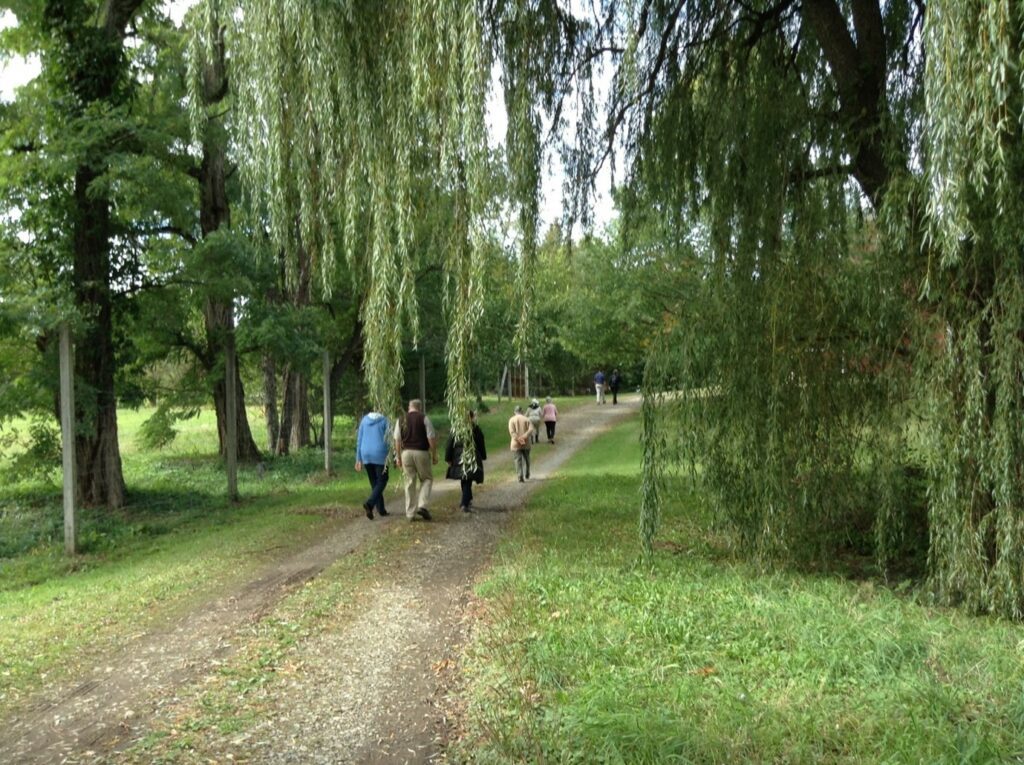
If I cannot sit still, how can I meditate? I can walk.
There are lots of ways that we can meditate, and they don’t always need us to sit still and not move. One way is to take a walk. Or, to put it another way, we can meditate while walking.
If we are not sure what we can meditate on, we can start with one question: Why do we walk?
I can surmise three global ideas. We walk: to get food, to get care, to find a place to be safe.
For these same reasons, animals walk.
Can we walk for something more human?
To feed and care for others in need, to look for shelter and assistance for other human beings as well as animals, and to explore our landscape.
Can we walk following a spiritual ideal?
There are many ways to explore the possibility of walking with a spiritual ideal. We can walk while repeating the Holy Name. Walking on a pilgrimage or walking in meditation.
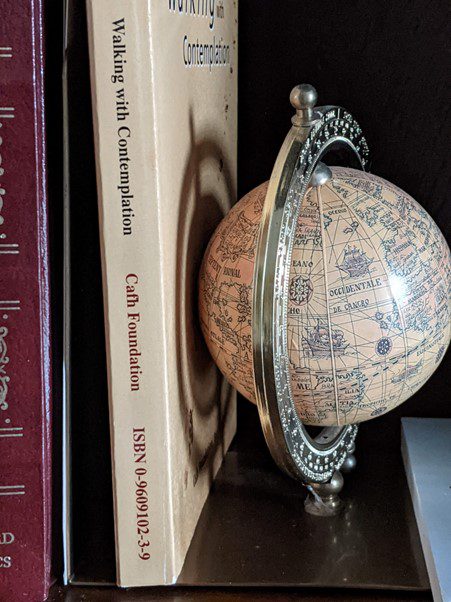
I was inspired by the book “Walking with Contemplation” which was a record of a series of walks in the San Francisco Bay Area.
Walking with Contemplation is an activity of Cafh Foundation, Inc., a nonprofit organization dedicated to spiritual development and unfolding.
The idea for these walks comes from the proposition that we can integrate themes of meditation as we walk on a selected path or through a garden or park.
As we walk, we may find inspiration in our surroundings. Often in nature, we find hope and the strength to continue forward in whatever challenge and work awaits us in our lives.
Opportunities for Walking
Though “Walking with Contemplation” inspired me, I like to call my walks Walking in Meditation.
I’ve been fortunate to have had lots of opportunities to walk in different areas and often in the same place in different seasons. Walking in Spring can inspire different meditations than when walking in the Fall or Winter.
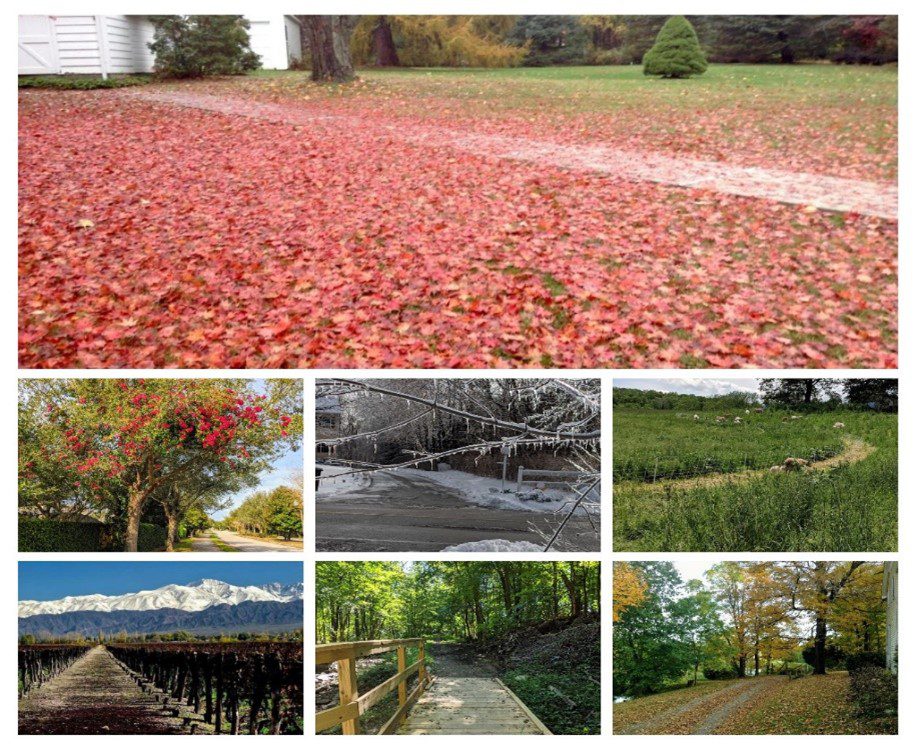
Some of my walks have taken me on inner journeys beyond the surroundings, but in practical terms, each area has its own beauty and inspiration. I’ve walked in Tivoli and Yorktown, New York, Ocoee in Florida, and through the vineyards in Mendoza, Argentina. Regardless of the location, I have found solace and inspiration when I practice the quiet art of meditative walking.
Seeking a quieter life
Very early in my life, in my search for a life of prayer and contemplation, I was inspired by the book The Russian Pilgrim.
It’s unknown if the book is literally an account of a single monk or if it is based on pilgrims who walk as a vehicle to practice ceaseless inner prayer. But the story really spoke to me and stirred a yearning in me for a deeper and more meaningful life.
When I started my life as a member of a spiritual community, our motto was “work and pray”.
We prayed as we worked in the kitchen or in the orchard, when doing laundry, as well as the established hours of meditation and vocalized prayers. In this practice, each prayer has an intention and is said aloud.
Later in the same community, I started working as a teacher. This meant that I was working with a group of young children and attending to their lessons. Naturally, the silence of living in the quietude of the community was reduced by the children’s banter and my need to focus on my work in the classroom, and I found that I kind of forgot about the practice of ceaseless inner prayer. I was very much distracted by my work.
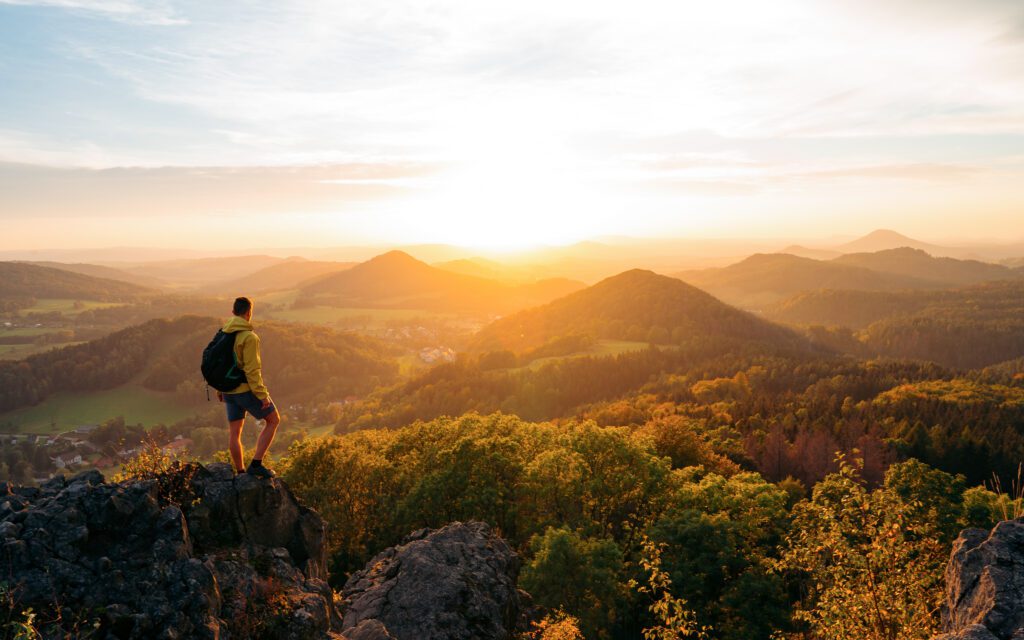
Rediscovering Silence through walking
The years passed, and I retired, after 50 years of working as a teacher. Glorious years, but with a lot of social distractions. Now I was free. I rediscovered silence and a kind of peaceful way of living.
My work consists of taking care of the garden, the house, and some cooking.
It might seem like a lot of work, but it is not.
I love it.
In spite of my work in the garden and the house, both my doctor and physical therapist recommended that I needed more movement – such is the life of a retiree – we need to move to stay healthy.
And, what they both recommended was: Walking.
Thankfully, I found in my neighborhood these wonderful paths to walk to my heart’s content.
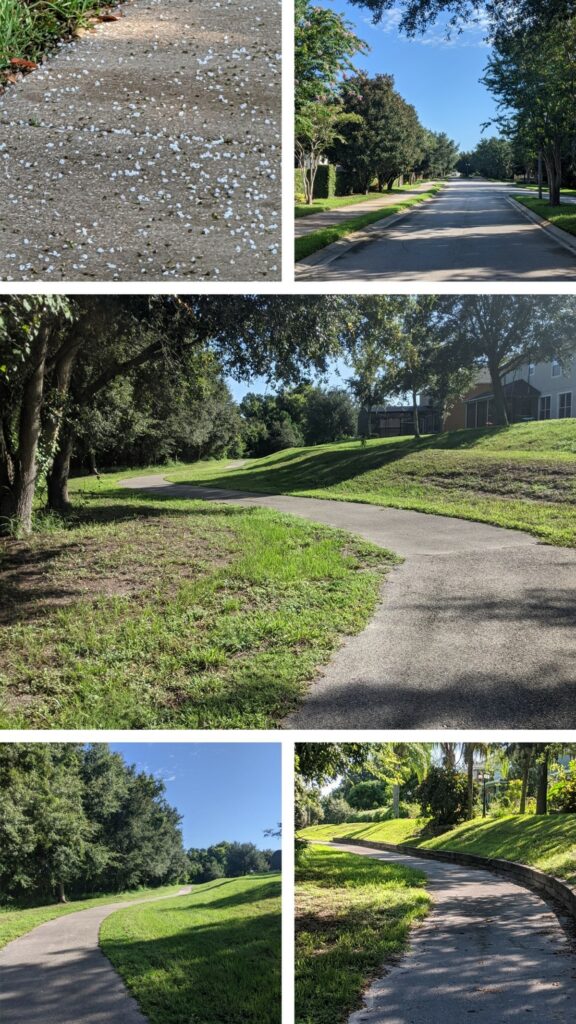
Setting a pace
Usually when we walk as a physical exercise, once we get into the rhythm and the pedometer counts our steps, our mind is free, and we know how to use it well during walking. Often, I’ve heard a comment in my head: “it’s time for the shopping list”. This means, mentally, we use the time we walk to remember or plan the groceries we need to buy, the things that need to be fixed, the appointments we need to schedule. The list can become very long. . . .
But for the walking meditation, I need to free my mind from “the shopping list” and focus on the theme of meditation that I have chosen beforehand.
As my body finds its rhythm, so do my mind and heart. My thoughts become quieter.
It does take a little preparation, and it is a practice that starts when I wake up.
Setting an intention while I walk
Every day, my first act upon awakening is a fervent elevation of thought to the Divine.
With that intention, I am ready to start my schedule for the day. Usually, I will plan a bit the night before for my walking meditation.
On the door I have pinned this prayer from an unknown author, that I like very much:
“Blaze, oh Resplendent One, the good path of my life, and help me to walk with those who cannot walk, with those who walk in pain, and those who walk in fear.”
I read this prayer on my way out the door to remind me of my intention of mindfulness as I walk.
Now, I’m ready to go.
As I walk, I like to pay attention to my surroundings, while being careful not to get distracted from my purpose of meditation. For that reason, I find it to be good to choose a theme; for example – “Today, let me be grateful for all I have received.”
Becoming aware of everything we receive leads us to be thankful, to be grateful.
“Feeling grateful is also a form of meditation.” Don Santiago Bovisio said that when he walked along a sidewalk, he mentally thanked those who laid the cobblestones, and this helped him realize how much farther he had to go to unite with the people who had worked and continued to work so that he could live as he lived.”
Following this idea, I greet and thank the gardeners that I see working along the path I’m walking on.
Observing while walking
A tree with its many branches providing shade is enough for awakening more thoughts about gratefulness. As I continue this theme as I walk, I give thanks for all those who accompany me in this life; family, friends, and neighbors – I give thanks, too, for those essential workers that oftentimes are invisible but help us in countless ways.
A flower, just a simple flower along the way brings me back to a special prayer: to pray for those who feel alone, those who think they are invisible to others, whose thoughts sometimes lead them to depression and anxiety.

Thinking about others during their difficult moments, in their sicknesses, as they face the death of dear ones: these are real and strong moments in life in which very often we feel alone.
These are the thoughts, the prayers, the meditations that a single flower by the road can create.
A single flower by the road, a picture in the steps of meditation, unites me with so many who feel alone.
And what if, instead of a flower, we find the presence of a single bird? What prayer does it inspire in you?
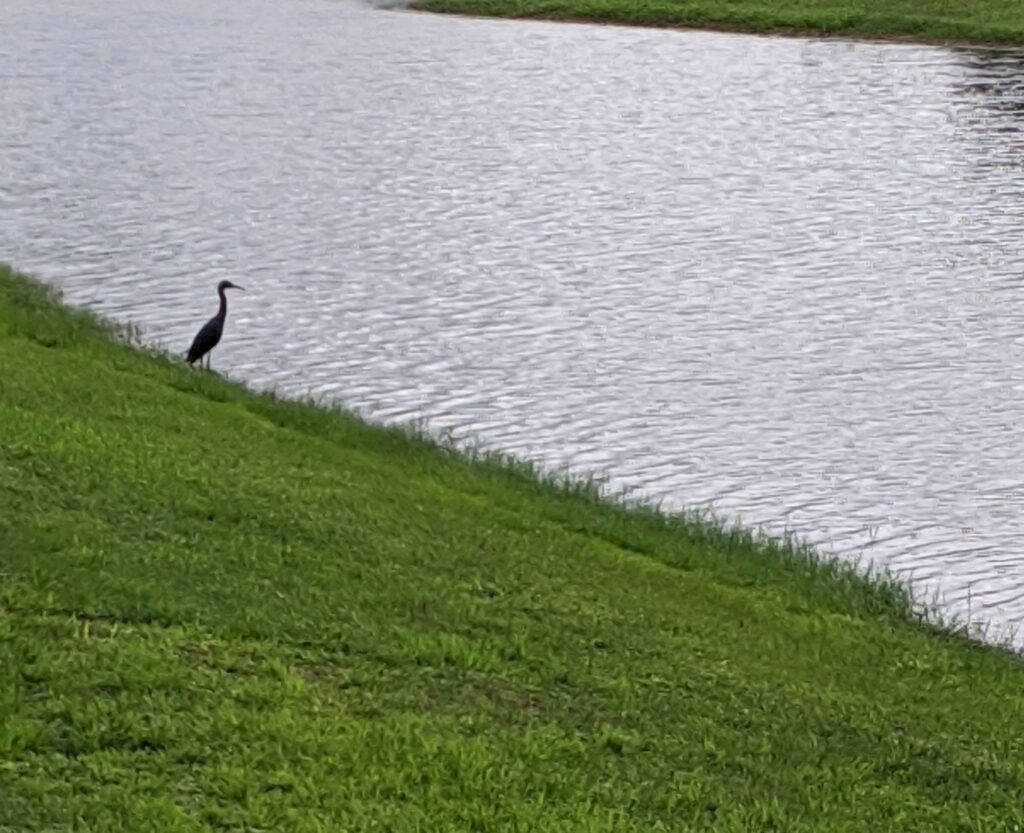
Using my senses to meditate while walking
There is another way of practicing meditation, and it is called the exercise of “the sensitive” meditation. In this kind of exercise, we use our senses to guide the meditation. For example, if we want to meditate on a rose, we look at it until our eyes are filled with its beauty, we smell its perfume, we try to feel its freshness in our mouth, imagine to touch its petals and listen to the poem of only one day that only a rose can sing.
Walking accompanying the sensitive meditation, we see the trees; we pay attention to the song of birds; we try to feel the air that surrounds us.
We can understand that things that we see, hear, smell, touch, and taste, bring us more messages than the immediate sensation that we feel.
Seeing beauty around me as I walk
Behind just the images of nature that we can encounter in our walks is the beauty and perfection of the laws of nature. Even in what seems to be imperfect.
A variation on the sensitive meditation could be to concentrate our attention on one of the five senses. For example, smell.
Breathe deeply. Try to smell something. Try to suspend any previous reaction to what you might be smelling. For example, just smell, whether it is an agreeable smell or not, whether it reminds me of something or not.
This exercise helps us to perceive without judging. For example, if something is disagreeable, we just stop our mind in the process of associating the sensation with something known to us. We stop judging. We just smell, and for a moment we are immersed in the perception of smelling.
To perceive without judgement
We can add to this exercise an imaginative picture that might lead us towards participation with the human family. For example, we can picture a room in a hospital and understand any kind of smell that can be associated with certain sicknesses or death.
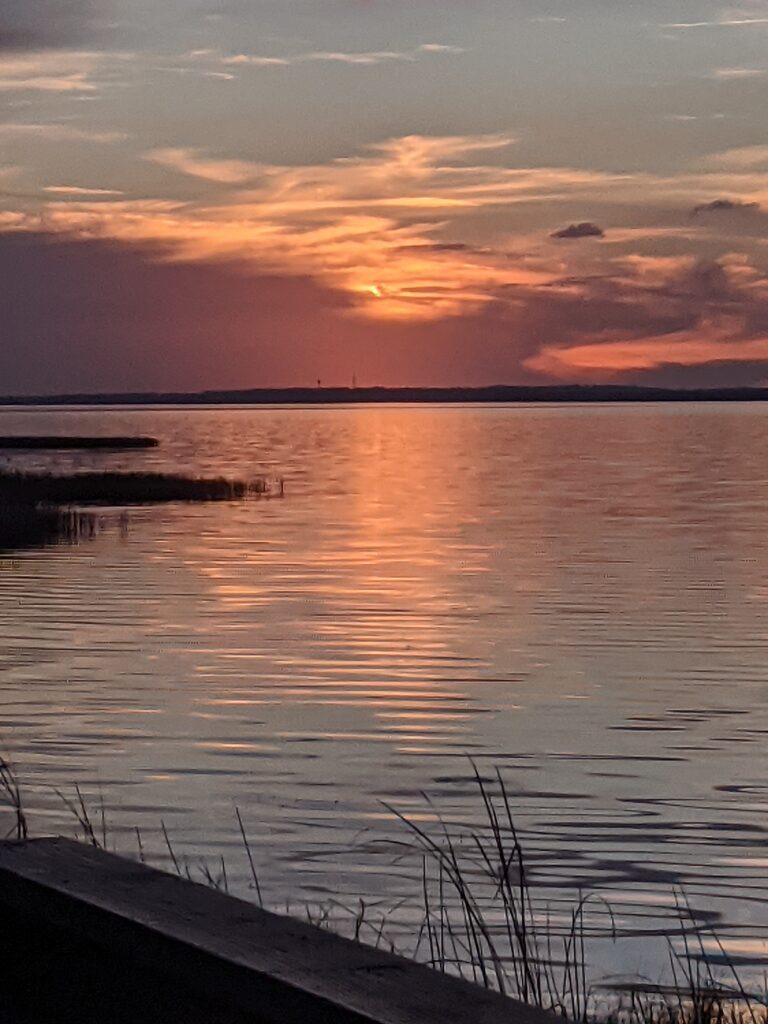
As I keep walking and trying to see and smell and hear what my senses perceive, I arrive at a place that I like very much: a small marsh on the shore of Lake Apopka.
For my sensitive meditation, the marsh is a very rich spot.
The smell… is different.
The view.… is one of nature, so unlike the well-kept lawns in the neighborhood.
The sounds… vary by the season.
So, what is here to enrich my sensitive meditation?
Everything.
Did you see the white flower? Look at the flowers below. At first, I did not see flowers in the swamp. I could not see them at first, because I didn’t expect to see them. It never occurred to me that flowers would grow in a swamp.
So, this teaches me that my preconceptions can make me not see. It also teaches me that beauty grows everywhere. I simply have to look, to really look.
The Swamp Rose Mallow, a native pink delicate flower, has taught me to appreciate the beauty that surrounds us in all different kinds of environments.
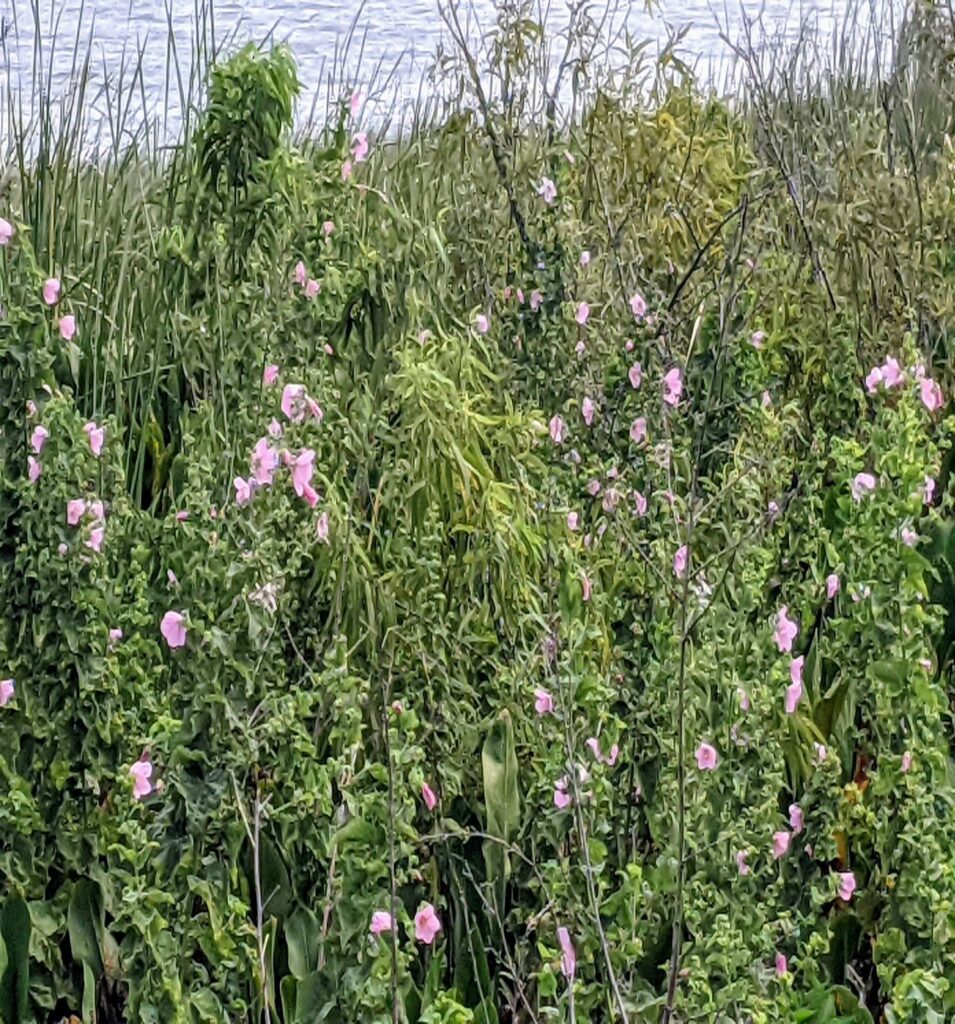
And as I focus on the flowers, I also try to use my sense of hearing and then I notice the sounds of the birds. Over time, I learn to distinguish the different varieties: The swamp hen or Moorhen, the purple Gallinule, the Limpkin, and not to forget the majestic Blue Heron, the White Egret, and the alligators that pretend to be indifferent to what goes on.
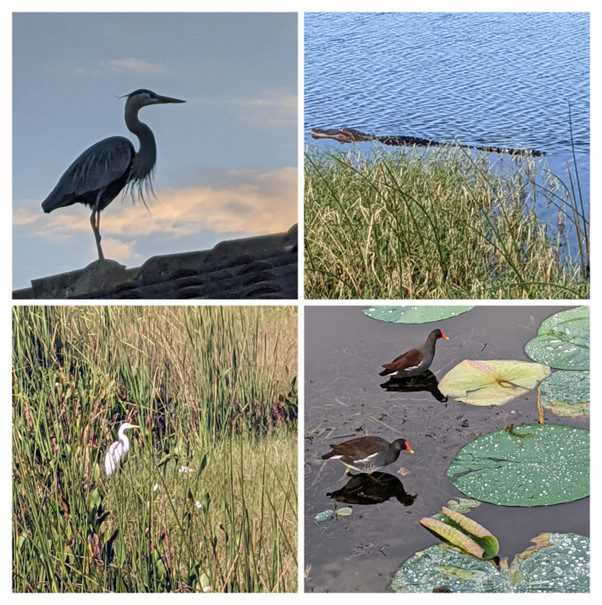
But see how I have become distracted, I’m not in a wildlife class. I am meditating – and so, I bring my attention gently back to my meditation.
Refocusing through walking
So, what are all these things that I perceive with my senses teaching me? I would say that all these perceptions help me to understand the subtle differences in our cultures. Just as I see and hear all the different birds and animals in this environment and do not judge that one should be here and not the other, on my walk, I also meet neighbors from different cultural backgrounds. And, I pay attention and honor their different characteristics, their customs, and their beliefs.
Becoming aware of our differences and our similarities, we realize that there is so much that we, as human beings, have in common; much more than our differences.
Greeting other walkers
As I walk, I greet other walkers, and I see in their faces the peoples of the world. One neighbor is from China, one is from Puerto Rico, one is African American, and another is from Haiti.
Often time our greetings are different, but one thing is in all faces: a great friendly smile.
Once I read that one should greet with the heart, with the intention of really wishing the person a Good Day. I try to fulfill that.
Often the time of my meditation ends as I arrive at the dock at the lake.
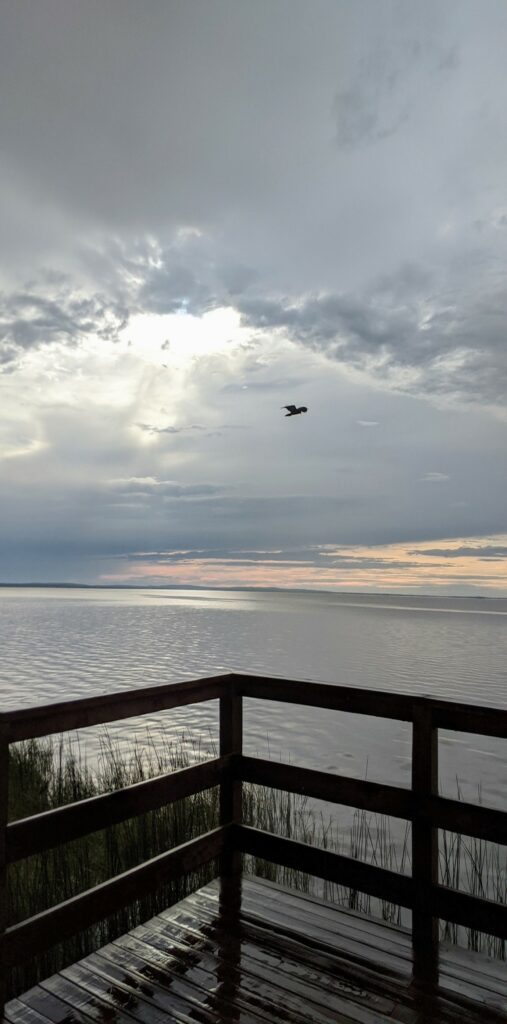
Ending the meditation, in front of this view, I pause in silence. I try to be in silence for five minutes. Sometimes it seems too long, and then I get distracted if there is movement in the swamp. I settle myself again and take into my heart the quietude.
When I walk in the afternoon, I often end in this same spot. This is the time that the sun is ready to end the day. It is submerging its light in the waters of the lake.
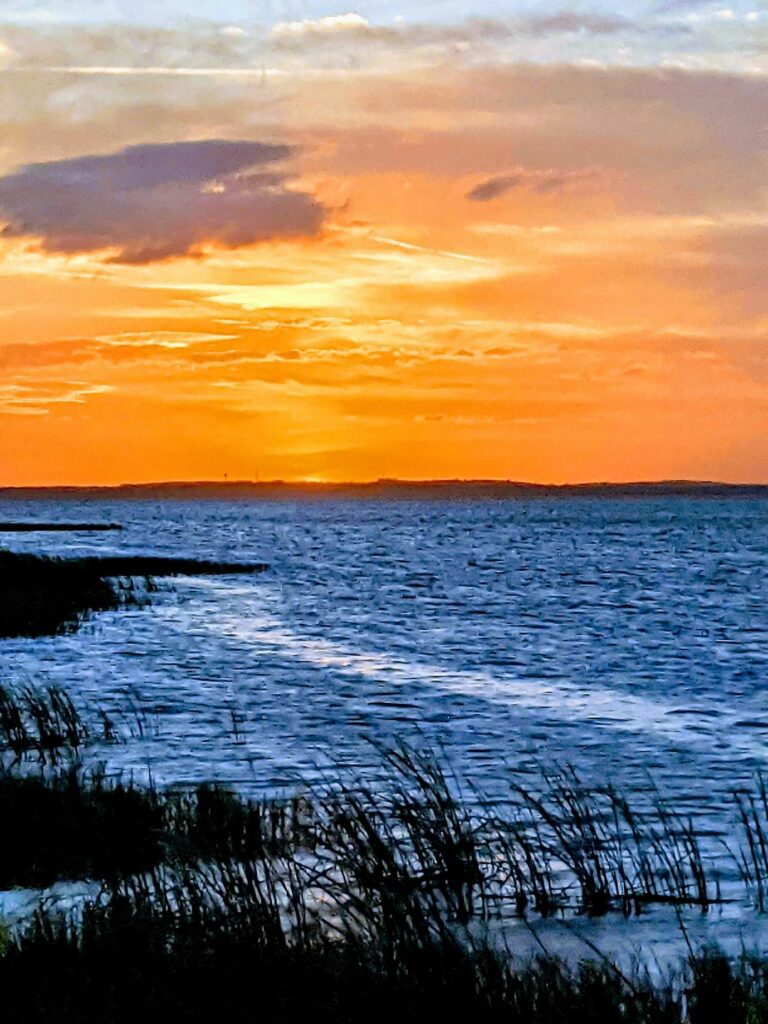
Here my walk stops, here my meditation ends. What more is there to say?
As the sun is leaving this day, my senses become quiet.
There are no noises from the swamp. This silence shows me that there is nothing more to elaborate on, no more steps to follow. I just need to be still, quiet and watch the sun as its flame disappears.
Another day is ending. What it was, now is gone.
Letting Go
This is the prayer that now is needed: to let go. To let go of some of the things that I hold during the day. Do they still need to be held? Can I let it go? Answers that I was expecting, solutions to inexplicable questions, do I need to still hold on to them? Or, as the day ends, can I let everything go, and be ready for another day tomorrow?
The pain, my pain that I was holding, waiting for it to go away.
Can I try to embrace it in a new way? Yes. I can recognize that my pain is not only mine. I share it with many other human beings, perhaps even some of my neighbors.
There are so many kinds of pain that we share by the mere fact that we are human beings.
Some people even turn their suffering into wisdom.
Who am I to expect no suffering? Even animals suffer on this earth.
Often time my pain is so little, in comparison with all that others are carrying.
But, for now, I shall be quiet, accept and offer, with all my imperfections.
Quietly the sun has set, a day is gone, fading into the past, allowing the future to become a new day.
About the Author(s)
Felicitas Castex is a retired elementary school teacher. She now enjoys walking and taking pictures of nature. She is continuously inspired by the messages revealed in all the life forms around us.


